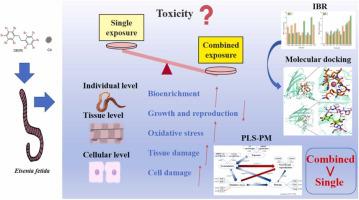当前位置:
X-MOL 学术
›
J. Hazard. Mater.
›
论文详情
Our official English website, www.x-mol.net, welcomes your
feedback! (Note: you will need to create a separate account there.)
Co-exposure of decabromodiphenyl ethane and cadmium increases toxicity to earthworms: Enrichment, oxidative stress, damage and molecular binding mechanisms
Journal of Hazardous Materials ( IF 12.2 ) Pub Date : 2024-05-21 , DOI: 10.1016/j.jhazmat.2024.134684 Zhihua Qiao 1 , Xinlin Sun 2 , Mengru Fu 1 , Shanqi Zhou 1 , Yanna Han 1 , Xuan Zhao 1 , Kailin Gong 1 , Cheng Peng 1 , Wei Zhang 1 , Fang Liu 3 , Chunmei Ye 3 , Jie Yang 3
Journal of Hazardous Materials ( IF 12.2 ) Pub Date : 2024-05-21 , DOI: 10.1016/j.jhazmat.2024.134684 Zhihua Qiao 1 , Xinlin Sun 2 , Mengru Fu 1 , Shanqi Zhou 1 , Yanna Han 1 , Xuan Zhao 1 , Kailin Gong 1 , Cheng Peng 1 , Wei Zhang 1 , Fang Liu 3 , Chunmei Ye 3 , Jie Yang 3
Affiliation

|
The increase of electronic waste worldwide has resulted in the exacerbation of combined decabromodiphenyl ethane (DBDPE) and cadmium (Cd) pollution in soil, posing a serious threat to the safety of soil organisms. However, whether combined exposure increases toxicity remains unclear. Therefore, this study primarily investigated the toxic effects of DBDPE and Cd on earthworms at the individual, tissue, and cellular levels under single and combined exposure. The results showed that the combined exposure significantly increased the enrichment of Cd in earthworms by 50.32–90.42 %. The toxicity to earthworms increased with co-exposure, primarily resulting in enhanced oxidative stress, inhibition of growth and reproduction, intensified intestinal and epidermal damage, and amplified coelomocyte apoptosis. PLS-PM analysis revealed a significant and direct relationship between the accumulation of target pollutants in earthworms and oxidative stress, damage, as well as growth and reproduction of earthworms. Furthermore, IBR analysis indicated that SOD and POD were sensitive biomarkers in earthworms. Molecular docking elucidated that DBDPE and Cd induced oxidative stress responses in earthworms through the alteration of the conformation of the two enzymes. This study enhances understanding of the mechanisms behind the toxicity of combined pollution and provides important insights for assessing e-waste contaminated soils.
中文翻译:

十溴二苯乙烷和镉的共同暴露会增加对蚯蚓的毒性:富集、氧化应激、损伤和分子结合机制
全球电子垃圾的增加导致土壤中十溴二苯乙烷(DBDPE)和镉(Cd)的复合污染加剧,对土壤生物的安全构成严重威胁。然而,联合暴露是否会增加毒性仍不清楚。因此,本研究主要研究DBDPE和Cd在单独和联合暴露下对蚯蚓个体、组织和细胞水平的毒性作用。结果表明,联合暴露显着增加了蚯蚓体内Cd的富集量,提高了50.32%~90.42%。对蚯蚓的毒性随着共同暴露而增加,主要导致氧化应激增强、生长和繁殖抑制、肠道和表皮损伤加剧以及体腔细胞凋亡增加。 PLS-PM分析揭示了蚯蚓体内目标污染物的积累与氧化应激、损伤以及蚯蚓生长繁殖之间存在显着而直接的关系。此外,IBR 分析表明 SOD 和 POD 是蚯蚓中敏感的生物标志物。分子对接阐明 DBDPE 和 Cd 通过改变两种酶的构象来诱导蚯蚓的氧化应激反应。这项研究增强了对复合污染毒性背后机制的理解,并为评估电子垃圾污染的土壤提供了重要见解。
更新日期:2024-05-21
中文翻译:

十溴二苯乙烷和镉的共同暴露会增加对蚯蚓的毒性:富集、氧化应激、损伤和分子结合机制
全球电子垃圾的增加导致土壤中十溴二苯乙烷(DBDPE)和镉(Cd)的复合污染加剧,对土壤生物的安全构成严重威胁。然而,联合暴露是否会增加毒性仍不清楚。因此,本研究主要研究DBDPE和Cd在单独和联合暴露下对蚯蚓个体、组织和细胞水平的毒性作用。结果表明,联合暴露显着增加了蚯蚓体内Cd的富集量,提高了50.32%~90.42%。对蚯蚓的毒性随着共同暴露而增加,主要导致氧化应激增强、生长和繁殖抑制、肠道和表皮损伤加剧以及体腔细胞凋亡增加。 PLS-PM分析揭示了蚯蚓体内目标污染物的积累与氧化应激、损伤以及蚯蚓生长繁殖之间存在显着而直接的关系。此外,IBR 分析表明 SOD 和 POD 是蚯蚓中敏感的生物标志物。分子对接阐明 DBDPE 和 Cd 通过改变两种酶的构象来诱导蚯蚓的氧化应激反应。这项研究增强了对复合污染毒性背后机制的理解,并为评估电子垃圾污染的土壤提供了重要见解。


















































 京公网安备 11010802027423号
京公网安备 11010802027423号